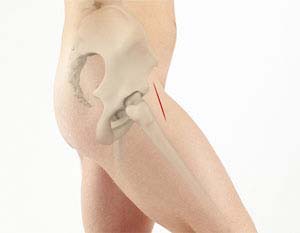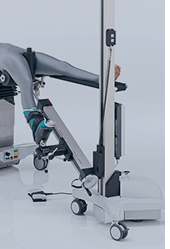Anterior Hip Replacement

The anterior total hip replacement has been developed with the goal of accelerating the rehabilitation time, decreasing the risk of dislocation and minimizing the possibility of a leg length discrepancy. The anterior approach to the hip is the only approach to the hip that does not require splitting or dividing muscles and tendons from the femur in order to obtain access to the hip joint. The approach is undertaken via a natural interval among muscles (the tensor fascia lata muscle and the rectus femoris muscle) to enter the hip capsule.
The anterior approach to the hip was first described in the late 1800′s and is routinely used for non-arthroplasty (non-joint replacement) procedures around the hip but only recently has it been innovated for the performance of a total hip replacement.

The anterior approach allows direct access to the acetabulum however access to the femur for the purposes of instrumentation is more difficult and less intuitive than the posterior or lateral approach to the hip. This has limited the availability of this procedure to many surgeons. Recently however, an operating room table has been developed which facilitates exposure of the femur through the same 3-4-inch incision. The table allows independent manipulation of operative extremity permitting extension, external rotation, adduction and elevation of the proximal femur out of the wound.
Since the muscles that power the hip (i.e. the abductor muscle mass) are not disturbed during surgery and the posterior capsule remains intact, the prosthetic hip attains near normal stability postoperatively. Patients are therefore not required to maintain the hip precautions that are required of them after posterior approaches to the hip. More accurate and consistent component positioning is ensured as well since the supine position and the radiolucent orthopaedic table facilitates the use of intraoperative fluoroscopy (X-ray). This allows the surgeon to place the components in the appropriate position, which also serves to decrease dislocation rates.
The preservation of the posterior hip muscles and capsule as well as the stability that is attained by the artificial hip eliminates the need to increase the leg length in order to stabilize the hip (a common reason for leg length discrepancy in the posterior approach). The live fluoroscopy as well as robotic technology allow for a very accurate matching of the operative hip to the contralateral hip achieving leg length equality.
Postoperatively, patients are encouraged immediate full weightbearing, hip precautions are almost never required and patients are encouraged to ambulate every couple of hours. Many patients are able to abandon all assistive devices such as canes and walkers within 1 week for indoor ambulation and most can ambulate unassisted outdoors within 2-3 weeks. A limp may persist for up to 3 months until muscle strength in the previously atrophied muscles is regained via regular therapy. Activities such as swimming and stationary bike are encouraged BY SIX WEEKS POST OP. High impact activities such as running, skiing or tennis however are restricted for a period of 3 months postoperatively in order to allow bone ingrowth into the prosthesis.
Which Patients Are Candidates for the Anterior Approach?
Most patients with osteoarthritis of the hip are candidates for this approach. Less ideal patients for the anterior approach are those with significant deformities of their proximal femur due to previous trauma. The procedure is available for all age groups and can also be performed in some overweight patients (BMI<40). Only the surgeon can determine if a patient is a candidate for the procedure although the vast majority of patients are.
Potential benefits of anterior hip replacement compared to the traditional hip replacement surgery, may include the following:
- Smaller incision (6-10cm)
- Minimal soft tissue trauma
- Reduced post op pain
- Shorter surgical time (average 60-90 minutes)
- Faster healing time
- Less scarring
- Earlier mobilization
- Less post operative restrictions
- Reduced hip dislocations
- Decreased hospital stay (90% of our patients undergo this surgery on an outpatient basis)
Normally, after a traditional hip replacement, your surgeon would give you instructions on hip precautions to prevent dislocating the new joint. Hip precautions are very restrictive and usually include the following:
- Avoid the combined movement of bending your hip and turning in your foot.
- You should sleep with a pillow between your legs for 6 weeks.
- Avoid crossing your legs and bending your hip past a right angle.
- Avoid low chairs.
- Avoid bending over to pick things up. Grabbers are helpful as are shoe horns or slip on shoes.
- An elevated toilet seat should be used.
For Anterior Hip Replacement patients, however, hip precautions are unnecessary. Because the muscles are not cut, the risk of dislocation is greatly lessened enabling the patient much more freedom of movement after surgery. Rehabilitation is much faster for patients as well due to less muscle trauma during the surgery.




